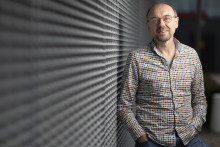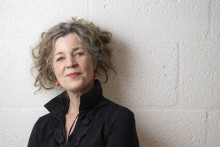It’s a secret. A secret known to precious few. This small group of insiders has allowed me to reveal something. For this secret might explain certain phenomena; but it goes deeper than that. Deeper than what your eyes can see. Deeper than the surface.
Our campus is vast. That means you sometimes have to walk or cycle for ages to get from one building to another. Not a big deal if you have the time and the sun is shining. But extremely frustrating if you have to rush to the next lecture or meeting and it’s raining cats and dogs. So you grab your bike, dash off and arrive at your destination soaking wet. Only to discover that the person you just saw at the previous location is already there: dry hair, freshly brewed coffee in hand, laptop already open. How is that possible?
The secret: there’s an underground campus. Under the grass and roads lies a network of pathways connecting all the buildings. It was built at the time of the Cold War, which began after the Second World War ended and created great tensions between the capitalist countries with the United States as the figurehead and the communist countries led by the Soviet Union. There were threats of war, nuclear weapons and land grabs.
In the Netherlands, too, people were afraid that the Russians were coming. So it's not surprising that shelters were built all over the country to keep people safe from missiles and nuclear bombs. Our campus was also built around that time: the first buildings were erected in 1961. And beneath them, radiation-proof shelters. In order to pull the wool over the eyes of the enemy, this information was confidential. What was even more secret were the corridors connecting the shelters. As wide as a decent-sized bike path. With every new building, corridors were added, creating an intricate system.
The entrances were cleverly hidden, in innocent-looking cupboards, behind grilles. And have you ever wondered why there’s a little church in the pond in front of Vrijhof?
The fall of the Berlin Wall in 1989 officially marked the end of the Cold War. However, the underground system is still intact. The lighting works. There are old-fashioned telephones on the walls. The ventilation runs through the High Pressure Lab. There are bunk beds in the shelters.
Only a small group of insiders knows this. It’s their job to get others to safety should the need arise. Did someone graduate or find a job elsewhere? Then they look for a successor. Not necessarily someone high up the ladder, but someone they trust, someone willing to help others. So perhaps that shy student is one of the insiders. Or that library worker. Or your colleague. And yes, sometimes they use the corridors to avoid getting wet when it rains and they need to get to another building quickly.
Our world looks less peaceful now than it did at the time the Wall fell. The war between Russia and Ukraine may spread over larger territory. China may also pose a threat. I think the shelters are somewhat too cramped for the current university community, but I would guess that the entire corridor system is large enough to provide some protection.
Some people dismiss this system as a fantasy. But I’d rather think of it as a tall but inspirational tale!






